1. Introduction
Commelina species are plant resources full of promise as future food and feed that thrive in diverse ecosystems with multiple purposes. In agricultural ecosystems, it has been reported that Commelina can be utilized as a leafy vegetable [1] [2], forage for ruminants [3], medicinal plants [4], crop protection [5], and fuel [6]. Moreover, a more recent report by Kinyuru and Kipkoech [7] indicates that Commelina species have been successfully utilized as feed for cricket insects in captivity with high-quality protein.
Commelina is commonly known as “Dayflower” or “Wandering jew” is a diverse genus of the family Commelinaceae widespread in the tropical and subtropical regions, and even warm-temperate regions of the world [8] [9]. This genus contains between 170 to 215 species worldwide [9] [10]. In the Flora of Tropical East Africa (FTEA), the genus comprises about 51 species, with some species (e.g. Commelina benghalensis) occurring with a number of unusual morphological variants [11] [12]. Members of the Commelina genus are ecologically diverse in East Africa [11] [12]. However, Commelina species may occur in a variety of habitats depending on local and regional factors. Some of the species in this genus have wide distribution, whereas others have narrow range distribution or even specific habitats; for instance: Commelina benghalensis L. has a broad range of habitats in the world [13], while Commelina albiflora Faden occurs only in Western Kenya, East Africa [11].
The Western part of Kenya adjacent to Lake Victoria is characterized by a unique climate supporting agriculture activities and life of different biological diversity. Lake Victoria is the largest lake in Africa, and approximately 6% of its shoreline zone resides in Western Kenya [14]. Due to agricultural activities, diverse weed communities grow in the riparian zones as well as floodplains adjacent to the lake. In agricultural ecosystems, the performance of weed communities has shown to be shaped by a complex system of multiple factors [15]. Local climate, altitude, soil properties, management, seasonality, and landscape factors might play important roles in influencing the diversity and distribution of weed species [16] [17] [18] [19]. It is an accepted fact that both various environmental and management are the major factors determining the main agricultural weed vegetation [17] [18]. However, the order of importance for both factors in terms of their impact on an ecosystem might be arguable as some studies have suggested that management factors are more important than environmental factors [17] [20] [21]. On contrary, other studies have described environmental factors as being the main determinant of weed vegetation [18] [22] [23]. It is therefore, necessary to evaluate the influence of these two factors for a more comprehensive explanation regarding drivers of weed vegetation in any agriculture system. Globally, many researchers have studied factors influencing seed germination of Commelina species [24] [25] [26] [27]. Yet, these studies treated few environmental factors (light, water stress, soil moisture conditions) in controlled environments. This approach based on controlled experiments for plant-environment interaction has shown limitations due to the large number of environmental factors not represented. For a solid underpinning of growth of Commelina at field level, several factors need to be examined. Regionally, numerous studies have successfully contributed to Commelina taxonomy [9] [11] [12] [28] [29] [30] and its usefulness [1] [2] [3] [6] [7]. So far, these studies described taxonomy, spatial patterns, occurrence and utilization of Commelina, without emphasizing on driving factors such as environment and management.
Our focus is to disentangle environmental and management factors governing Commelina species in selected agro-ecological zones in Western Kenya. Unravelling these factors will contribute to prioritization of ecological aspects leading to the growth conditions of Commelina species. This is a pioneer study investigating the environmental and management factors affecting Commelina species at field level.
The objectives of this study are 1) to assess the diversity of Commelina and determine composition of associated weed species across various agro-ecological zones in Western Kenya, and 2) to evaluate environment and management factors affecting the diversity and distribution of Commelina species.
2. Material and Methods
2.1. Study Site
The present study was carried out between October-December 2020 in three Kenyan counties (Siaya, Kisumu and Homabay) alongside Lake Victoria in Western Kenya. This part of the Kenya covers Nyanza and Western regions covering together 19,877 sq km, making up 3.41% of the total area of the country. Kenya is mostly divided in seven agro-ecological zones, with the western Kenya classified between zones I and III characteristics with humid to sub-humid climate [31] [32]. The vegetation varies from moist forest in elevated lands to woodlands, wetlands, and even croplands adjacent the Lake Victoria, with a precipitation varying between 1200 - 1600 mm per annum. The main soils are mostly a mixture of acrisols, nitrosols, ferralsols and cambisols [33] [34] suitable for agriculture [35]. In this part of the country, several crops are grown by smallholder farmers. This includes maize, sorghum, rice, bean, vervet bean, kale, tomato, spinach, cabbage, nightshade, spider flower, onions, sugarcane, citrus, orange, mango, avocado, papaya, sweet potato, cucumber, groundnut and cotton. Predominance of conventional system is adopted and applied by farmers as cultural practice, but can also follow certain techniques/methods such as crop spacing, crop establishment, farming methods, manure inputs and control of weed. The farm lands in the three counties comprised 12 production sites under two agriculture system types, the rainfed and irrigation systems. These production sites adjacent Lake Victoria were chosen due to accessibility and area where agriculture activities were still taking place (Figure 1). Geographically, these sites undulate at an altitude ranging between 1121.9 m and 1174.4 m above sea level.
2.2. Plant Sampling
Purposive sampling technique was employed to collect Commelina species in farmer fields using quadrat of 1 × 1 m size. Since farmer fields comprise small hectarage with irregular shape, the number of sampled fields differed between production sites. Hence, three quadrats per field were sampled to maintain the uniformity of field corresponding to 180 quadrats recorded in total of our study area. Commelina species and associated weed species were recorded following phytosociological method determined by Mueller-Dombois and Ellenberg [36] that consist of counting all individual species in a quadrat. Identification of weed species was captured using field guides [37] [38], regional flora for comprehensive identification of Commelinaceae family [11] [12], and AFROweeds identification tool [39]. Weed species difficult to identify in the field were collected and pressed for later determination at the East African Herbarium (EAH) of the National Museums of Kenya. Correct species names were verified using The Plant List [10] and [11] for Commelina plants. Life-cycle of weed species were classified in five groups (annuals, perennials, short-lived perennial, parasitic and unknown).
![]()
Figure 1. Map indicating the location of the study area in Western Kenya (Production sites located in Siaya, Kisumu and Homabay counties): 1, Siaya-Nyamonyi; 2, Siaya-Abawa; 3, Siaya-Wariada; 4, Siaya-Waguso; 5, Kisumu-Korando; 6, Kisumu-Namutoyi; 7, Kisumu-Kashule-Coloa; 8, Kisumu-Aero; 9, Homabay-Konyango; 10, Homabay-Wahamblah; 11, Homabay-Angalo; 12; Homabay-Kisui.
2.3. Explanatory Variable
In our study area, 60 soil samples were used to explain consistency of environment nutrient variables background on Commelina species. Soils were sampled at a depth of 0 - 20 cm [40]. After sampling, the soils were labelled, air-dried, sieved with 2-mm aperture and placed in plastic bags. Later, about 200 grams of each soil sample from same production site were combined in a composite sample to be submitted for laboratory analysis at Kenya Agriculture and Livestock Research Organization (KALRO) in Nairobi. The analysis included soil pH, electric conductivity (EC), total organic carbon (TOC), total nitrogen (TN), available phosphorus (P), cationic exchange capacity (CEC), exchangeable Ca, Mg, K, Na, exchangeable sodium percentage (ESP) and soil texture (silt, sand and clay). The concentration of TN, TOC, CEC, Exchangeable Ca, Mg, K, Na, ESP and soil texture class (silt, sand and clay) were expressed in percentage, whereas available P was expressed in ppm (party per million) and Electric conductivity (EC) expressed in mS/cm (millisiemens per centimeter). The Soil pH and EC were determined in a 1:2.5 (w/v) soil-water suspension with a pH meter and conductivity meter, respectively [41]. For the determination of Ca, Mg, K, Na and CEC, soil samples were leached with 1N ammonium acetate buffered at pH 7. The leachates were analyzed for exchangeable Ca, Mg, K and Na. Furthermore, samples were leached with 1N KCl, and the leachate was used for the determination of the CEC. The determination of Na and K elements were done with a flame photometer, whereas Ca and Mg elements were determined with AAS (atomic absorption spectrophotometer). The CEC was determined by distillation followed by titration with 0.01 N HCl [42]. Conventional routine methods were used to determine TOC [43], available P [44] and TN [45]. The soil texture (proportion of silt, clay and sand) was determined by the Hydrometer method [46].
For management in fields, 60 farmers were asked semi-structured questions about farming method, crop establishment, crop spacing, weed control, cost of weed control, fertility and agriculture system type to understand the background of these variables on Commelina species. As part of environment variable, description of surrounding vegetation was recorded through field observation. Such information was captured on open questionnaire pre-installed in ODK tools (ODK collect v1.28.2). The derivation of surrounding vegetation and management variables are presented in Supporting information: TableS1.
3. Data Analysis
To assess the relative density of weed species in quadrats, absolute density was measured as total number of individual species per total number of quadrats studied. The relative value was obtained by dividing absolute value by total value for all species multiply by 100 percent, calculated in Microsoft Office Excel 2021® program.
The diversity indices of Commelina species among production sites was evaluated as Shannon-Weaver (H) diversity index [47], Pielou’s evenness (E) index and Margalef index (M). These indexes were calculated following the equations:
(1)
(2)
(3)
where Pi is the proportion of all observations in the ith species, N the total number of individuals of all species in the sample, Ln = logbasen and S the number of unique species per quadrat. Higher value of these indices indicates high diversity and lower value a low diversity, a value of indices equals to 0, indicates community dominated with only one species.
Differences in environment nutrient variables among production sites were assessed by the analysis of variance (ANOVA). At all analysis, pairwise comparison evaluated significance of means for any difference in variable among production sites using Turkey’s Honest Significant Difference test (p < 0.05). All 14 nutrient variables were normalized by logarithmic [log(x + 1)] transformation to meet the assumptions of normality because one unit variation in nutrient concentration is considered as much more important at low than it is at high concentrations [48].
The relationship between diversity of Commelina species, environment and management variables were evaluated using multiple linear regression analysis. Shannon-Wiener diversity index (H’), Pielou’s evenness index (E) and Margalef index (M) were considered as responses, whereas environment and management variables were predictors. Selection of best model depended on statistic methods for Adjusted R2 values and difference between models for Akaike’s information criterion and Bayesian information criterion. The standardized beta coefficients, ranked the order of predictors in term of their contribution to the model. In multiple linear regression, significant (p < 0.05) environment nutrient variables with variance inflation factor (VIF < 20) were used as dropping threshold. This procedure resulted in elimination of two variables: calcium and cationic exchange capacity due to high multicollinearity (Supporting information: TableS1). Analysis of variance and multiple linear regressions were employed using STATA 14.2 statistical software (Stata Corp LLC, Texas, USA).
To explain the relationship of weed species—explanatory variables, multivariate statistical analysis as ordination technique was employed [49]. Prior to multivariate analysis, we prepared three matrices in form of tables: 1) weed count with r rows and c columns (r = 180 quadrats; c = 115 species); 2) weed count with r rows and s columns for Commelina species (s = 11 species); 3) an environment and management matrix with r rows and v columns (v = 22 variables) of which 14 quantitative environment nutrient variables: electric conductivity (EC), soil pH, total organic carbon (TOC), total nitrogen (TN), available phosphorus (P), cationic exchange capacity (CEC), Exchangeable Ca, Mg, K, Na, exchangeable sodium percentage (ESP), soil texture (silt, sand and clay) and seven qualitative variables, management recorded into “binary dummy” variables (farming method, crop establishment, crop spacing, weed control, cost of weed control, fertility and agriculture system type). Description of surrounding vegetation as environmental variable was also recorded as “binary dummy”. To achieve the assumptions of normality, weed count data were square-root transformed, which is considered the most appropriate for count data in quadrat [50], while quantitative environment nutrient variables follow a logarithmic [log(x + 1)] transformation. The scientific names of all recorded weed species were replaced by their five-character EPPO codes (European and Mediterranean Plant Protection Organization [51]).
At first, we run a detrended correspondence analysis (DCA) on the entire data set (180 quadrats by pattern of 115 species) to detect ecological conditions of Commelina species and composition of associated weed species. Because some Commelina species were recorded with low counting, rare species were not down-weighted or selected following a specific criterion to allow maximum differentiation among species.
Secondly, we performed a canonical correspondence analysis (CCA) to link the relationship between the distribution of Commelina and explanatory variables. The data set of 180 quadrats by patterns of 11 Commelina species revealed a unimodal rather than linear ordination technique checked by DCA depending on the gradient length (SD units > 3) [52]. Hence, we subjected our data to a canonical correspondence analysis (CCA, assuming unimodal response) using methods recommended by Lepš and Šmilauer [50]. All multicollinearity issues among explanatory variables were checked by discarding variables with variance inflation factor (VIF = 0 or VIF > 20; [52]). We analyzed marginal and conditional effect using forward selection to rank importance of explanatory variable that build our minimal significant model. Only significant explanatory variables were used for CCA ordination to improve explanation of variables in the diagram, and variables with non-significance (p > 0.05) were excluded [53].
Lastly, a partitioning variation of the two sets of explanatory variables (“environment” and “management”) was assessed using Commelina data set (180 quadrats by patterns of 11 Commelina species). Partitioning variation was helpful to quantify fraction of variation explained of each single effect of explanatory set (“environment” and “management”, respectively) and “shared” effect (environment × management). This was resulting in the summation of all fractions (“environment” + “management” + “shared” effect + U, with U being the unexplained variation). To achieve this approach, a series of CCAs and partial CCAs (pCCAs) were carried out following Borcard et al. [53] steps: 1) a CCA with all two explanatory variable sets (environment and management) initiated for quantification of fraction of total amount of variation explained (TAVE), no covariable was included; 2) a pCCA with one of the two explanatory variable set as environmental variable and the other as covariable to get single effect for each set of explanatory variable; 3) variation of shared effect interaction between explanatory variable sets was calculated; 4) unexplained proportion of variation was calculated (100-TAVE). Analyses of DCA, CCAs and pCCAs ordinations were performed using CANOCO program (version 4.56 [54]) and CanoDraw for Windows (version 4.12 [54]) to visualize the graphs generated by DCA and CCA.
4. Results
4.1. Species Diversity
In total, 115 weed species representing 80 genera from 30 families were recorded. Members of five families constituted 66 species (57.3%) of the total flora, Asteraceae (18 species), Poaceae (15 species), Commelinaceae and Fabaceae (12 species) and Cyperaceae (9 species) (Figure 2). Families (e.g. Amaranthaceae, Malvacae, Euphorbiaceae, Solanaceae) constituted six, five and four species, respectively. The remaining flora were composed by monogeneric families (14) represented by single species (e.g. Apiaceae, Molluginaceae, Onagraceae, Orobanchaceae, Pondeteriaceae). The genera with the highest number of species were Commelina (11 species) followed by Cyperus and Amaranthus (4 species) and finally Desmodium and Crotalaria (3 species). Rank of ten weed species with high density in our study area was: Cynodon dactylon, Parthenium hysterophorus, Commelina diffusa, Cyperus rotundus, Xanthium strumarium, Echinochloa colona, Stachytarpheta jamaicensis, Portulaca oleracea, Bidens Pilosa and Digitaria abyssinica. The list of all recorded plants species is presented in Supporting information: TableS2. Regarding Commelina species, 11 species were recorded (Picture 1) of which C. diffusa and Commelina benghalensis var. benghalensis (non-Hybrid variant) were the two species with high relative density (8.87% and 1.60%, respectively). In term of diversity of Commelina species per production site, Abawa had greater diversity and Aero presented a low diversity (Supporting information: TableS1).
![]()
Figure 2. Representation of numbers of genera and species per family. Only families with two species are shown, whereas other families (14) are reported with only one genera and one species.

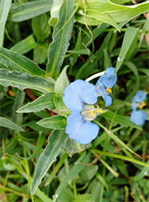

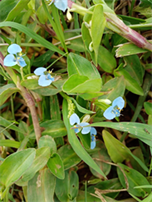
(a) COMDI (b) COMPU (c) COMEL (d) COMAF
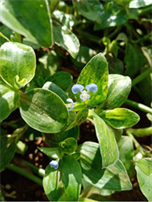

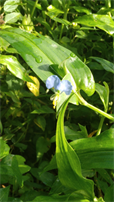
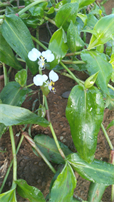
(e) COMPE (f) COMLA (g) COMBE 1 (h) COMBE 2
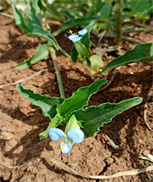
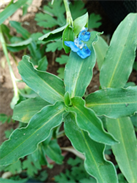
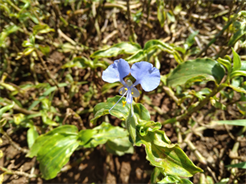
(i) COMSP (k) COMFO (j) COMKO
Picture 1. Picture of the 11 Commelina species recorded in agro-ecological zones of Western Kenya. COMDI: Commelina diffusa; COMPU: Commelina purpurea; COMEL: Commelina erecta subsp. livingstonii; COMAF: Commelina africana; COMPE: Commelina petersii; COMLA: Commelina latifolia var. latifolia; COMBE1: Commelina benghalensis var. benghanlensis (non-hybrid variant), COMBE2: Commelina bengalensis (hybrid variant); COMSP: Commelina sp., COMFO: Commelina forskaolii; COMKO: Commelina kotschyi.
4.2. Effect of Variables on the Diversity of Commelina Species
The analysis of variance (ANOVA) indicates that eight environment nutrient variables (TN, available P, pH, EC, CEC, Ca, Mg and ESP) were significantly (p < 0.05) different between production sites, whereas TOC, K, Na and soil textures (sand, silt and clay) did not show significant (p > 0.05) differences (Supporting information: TableS1).
According to the model comparison methods, multiple linear regression analysis showed the Margalef index (M) fitting the best model with significant 10 variables that combine ESP, Mg, soil pH, TN, agriculture system type, crop spacing, weed control, EC, crop establishment and available P. The Shannon-Weaver (H) diversity index and Pielou’s evenness index (E) were also significantly related to 10 predictors. To rank the most important predictor in the best model, high value of standardized beta coefficient for ESP, Mg, soil pH, TN, agriculture system type showed stronger effect on the diversity of Commelina species (Table 1).
4.3. Detrended Correspondence Analysis
The detrended correspondence analysis run for the entire 115 weed species (Figure 3(a)) detect difference ecological conditions for Commelina species and composition of weed species. For instance, Commelina erecta subsp. livingstonii and Commelina africana set to the right part of the graph are together accompanied with eight weed species typical for cultivated upland fields under rainfed system. This included the species Withania somnifera, Athroisma stuhlmannii, Sida cordifolia, Setaria verticillata, Crotalaria retusa, Solanum incanum, Achyranthes aspera and Striga hermonthica. As the field condition increases with the degree of water level, species mostly related to the irrigated system occurred. Hence, Commelina species namely, C. diffusa, C. benghalensis var. benghanlensis (non-hybrid variant), Commelina petersii, Commelina forskaolii, Commelina bengalensis (hybrid variant), Commelina kotschyi and Commelina sp.) positioned at the center of the diagram occurring in both rainfed and irrigated systems. Weed species associated with C. diffusa included Echinochloa colona, Eleusine indica, P. oleraceae, Leonotis nepetifolia, Galinsoga parviflora and Stephania abyssinica, whereas Gomphrena celosioide, Euphorbia heterophylla, Senna obtusifolia, Dactyloctenium aegyptium, Desmodium incanum and Acanthospermum hispidum accompanied C. benghalensis var. benghanlensis (non-hybrid variant). The Commelina plants (C. petersii, C. forskaolii and C. bengalensis-hybrid variant) were all together associated with five weed species (Desmodium tortuosum, Ischaemum rugosum, Sida acuta, Boerhavia diffusa. and Malvastrum coromandelianum, whereas C. kotschyi was associated with three species (Euphorbia hirta, Amaranthus spinosus and Parthenium hysterophorus). The species Commelina sp. was related with Crotalaria brevidens, Pycreus lanceolatus, Sporobolus pyramidalis and Asystasia gangetica. As for Commelina latifolia var. latifolia and Commelina purpurea located to the left part of the graph, are exclusive under irrigated system mostly inundated by water. For instance, C. latifolia var. latifolia was accompanied with three semi-aquatic weed species (Phragmites australis, Typha domingensis, Mimosa pigra and Echinochloa pyramidalis) preferring prolonged water supply, whereas C. purpurea was mostly accompanied with an aquatic species Centela asiatica.
4.4. Canonical Correspondence Analysis
4.4.1. Variance Partitioning
Results from CCA and pCCA analyses identify the total amount of variation explained (TAVE) with single effect of “environment” and “management”, and
![]() (a)
(a) ![]() (b)
(b)
Figure 3. Plot (a) is showing results of detrended correspondence analysis (DCA) ordination diagram for Commelina species (underlined in red) with associated weed species, 115 species (Δ) refer to EPPO codes [51] provided in Supporting information: Table S2. Plot (b) is showing results of canonical correspondence analysis (CCA) ordination diagram for Commelina species with significant explanatory variables (soil and management). Commelina species (Δ); Environment variables (red arrows) and dummy management variables ( ). Abbreviations of the 11 Commelina species: COMPE: Commelina petersii; COMKO: Commelina kotschyi, COMPU: Commelina purpurea; COMFO: Commelina forskaolii; COMAF: Commelina africana; COMBE1: Commelina benghalensis var. benghanlensis (non-hybrid variant), COMBE2: Commelina bengalensis (hybrid variant); COMEL: Commelina erecta subsp. livingstonii; COMLA: Commelina latifolia var. latifolia; COMDI: Commelina diffusa; COMSP: Commelina sp. The first axis is horizontal, and the second axis vertical. The length of the vector is linked to its importance. The angle between two vectors reflects the degree of correlation between variables, and the angle between a vector and each axis reflects its correlation with the axes.
![]()
Table 1. Multiple linear regression analysis between diversity of Commelina—Shannon-Weaver index (H), Pielou evenness index (E) and Margalef index (M), environment (pH, TN, P, EC, Mg, ESP, SurV) and management (FarmM, CropS, Fertility, AgriSysT, WeedCont and CropE in Western Kenya. Prior to analysis diversity indices and environment variables were standardized.
Note: Akaike’s information criterion (AIC), Bayesian information criterion (BIC), Adjusted R-square (Adj R2), p-value and standardize beta coefficients (SßC) of regression model are shown. TN = total nitrogen, P = available phosphorus, EC = electric conductivity, Mg = magnesium, ESP = exchangeable sodium percentage, SurV = surrounding vegetation, FarmM = Farming method, CropS = Crop spacing, AgriSysT = Agriculture System Type, WeedCont = weed control, CropE = Crop establishment.
shared effect (environment × management). The single effect of “environment” explains 10.57% of the total variance in the Commelina data set, not explained by “management”. The single effect of “management” explains 5.97% of the total variance not accounted for “environment”. The total shared variance of environment × management was −0.4%, indicating that variance explained by this interaction was minor than single variance explained by the environment and management, individually. The total amount of variation explained (TAVE) was 16.14%, whereas 83.86% remained unexplained (U) (Table 2).
4.4.2. Variables Ranking
The marginal effect indicates variance explained if only single variable is used and pH is the most important explanatory variable followed by crop establishment, fertility, agriculture system type, K and available P. In this context, the remaining variables plays secondary role. After the pH variable is selected and all the variables are included in the ordination model, crop establishment, K and agriculture system type decrease dramatically, whereas TN, crop spacing and available P increase. During the forward selection with the set of Monte Carlo tests (999 permutations), the conditional effect indicates highly significant (p < 0.01) increases for pH and available P. The variables TN, fertility and crop spacing conferred significant (p < 0.05) (Table 3). All other variables remained not significant. Important explanatory variables that construct our minimal model were pH, available P, TN, fertility and crop spacing. The Variance Inflation Factors (VIFs) were all below 10 (Table 3), indicating low collinearity, and hence little redundancy among variables.
4.4.3.Commelina Species—Explanatory Variables Relationship
Results from this relationship are presented in Table3, Figure 3(b) and Supplementary information: TableS3. The Monte Carlo permutation test shows first canonical axis and all canonical axes highly significantly (p < 0.002, F-ratio = 10.501; p < 0.001, F-ratio = 2.091; 999 permutations under reduced model).
![]()
Table 2. Variation partitioning of the Commelina data matrix.
![]()
Table 3. Variable explaining Commelina data set obtained from summary of forward selection and inter-set correlations of the explanatory variables with the first two ordination axes from the canonical correspondence analysis (CCA).
Note: λ1 (marginal effects) = variance explained without considering other variables and λA (conditional effects) = variance explained at the time it was included in the model; VIF (Variance Inflation factor). **Highly significant, p < 0.01; *Significant, p < 0.05; ns = not significant, p > 0.05.
Significant canonical axes indicate strong relationship between Commelina data set and explanatory variables. Additionally, CCA showed strong ecological relationship between Commelina data set and the considered explanatory variables, with species-environment correlations of 0.74 and 0.65 on the first and second axes, respectively. Only the first two canonical axes (75.2%) were used because of the high explained variability in Commelina data set. The total inertia stated by the CCA model was 7.564 (Supporting information: TableS3). The projection of significant environmental variables on axis 1 reveals positive correlation with soil pH and available P content and negative correlation with TN as indicated by the interset correlations (0.594 and 0.292, −0.044, respectively) (Table3; Figure 3(b)). Axis 2 was positively correlated with TN, but negatively correlated with soil pH and available P content. The position of Commelina forskaolii is closely related to soil pH and soil rich in available P content. Similarly, Commelina benghalensis 2 (hybrid variant) is predicted to have it optimum with respect to soil type rich in available P content. Commelina latifolia var. latifolia and Commelina sp. confounded on same position are also predicted to occur in soil rich in available P content, although not strongly linked as it is for the two previous Commelina species. The species Commelina purpurea and Commelina petersii corresponds to a soil rich in TN content, whereas Commelina africana and Commelina erecta subsp. livingstonii in an opposite direction refers to soil poor in TN. The position of Commelina benghalensis var. benghanlensis 1 (non-hybrid variant) and Commelina diffusa near the origin of the ordination diagram is an indication of these species to thrive in wide ecological field conditions. The two dummy management variables (fertility and crop spacing) having also their centroid near the origin, indicate major effect on Commelina species. However, it is suggested that fertility might have higher effect on Commelina species than crop spacing (interset correlation 0.331 and −0.151 with axis 1; Table3) regarding agricultural inputs.
5. Discussion
The floristic analysis of our study area showed that the majority (57.3%) of the recorded flora were composed with five important families, Asteraceae, Poaceae, Commelinaceae, Fabaceae and Cyperaceae. This result was consistent with the finding in adjacent agro-ecological zone in Kiisi County [55]. The families of Asteraceae, Poaceae, Cyperaceae and Fabaceae have been previously considered among the common pattern in the riparian zones and adjacent of the Lake Victoria basin [56]. Additionally, surrounding vegetation adjacent to our study area proven the establishment of heliophylic families. Indeed, we found that the diversity of Commelina species was significantly related to nutrients (ESP, Mg, pH, TN, EC and available P) and management variables (agriculture system type, crop spacing, weed control, crop establishment). One of the reasons for the environment nutrient variables to affect the diversity of Commelina species could be attributed to greater accumulation of these elements at the topsoil near the Lake as discussed by Fungo et al. [57], mostly beneficial to plants species with low rooting systems. For instance, the ability of soil sodicity known as exchangeable sodium percentage (ESP) to affect the diversity of Commelina can be attributed to the soil irrigated by water containing residual of sodium carbonate. According to Orina et al. [58] [59], the water body of Lake Victoria has experienced several changes regarding physico-chemical properties in the last past decades caused by human activities increasing toxic pollution from inappropriate application of fertilizers, industrial and domestic waste discharge considered as secondary source of sodicity. Another possible reason for these nutrients to affect the diversity of Commelina species is perhaps that, our study area is predominant with hand hoe tillage in a perennial cropping system. A report by Steenwerth et al. [60] suggested that in a perennial system where hand hoeing tillage is the main land preparation there is limited change in vegetation leading to less leaching of base cations in comparison to annual cropping systems. Nevertheless, agriculture system type among management variables exerts important effect on the diversity of Commelina as these plants showed some preferences regarding water degree in either irrigated or rainfed systems. Furthermore, the occurrence of Commelina plants in farmer fields have been related to high proliferation of these species through both asexually (or vegetatively) and sexually (aerial and subterranean seeds) mostly coinciding with agricultural inputs [5].
The current investigation showed that species with high relative density were predominant. Four annual species (grasses, E. colona and D. abyssinica; broadleaves, B. pilosa and P. oleracea) and two perennial species (sedge C. rotundus and grass C. dactylon) were the most dominant with the highest relative densities. This confirmed earlier report in western part of Kenya, reviewed by Odhiambo et al. [61] [62]. Additionally, E. colona, C. rotundus, C. dactylon and B. pilosa were documented as world’s worst weeds of many crops [13]. The potential of these weed species to infest and grow fast in many cropping systems is explained through seed dispersal mechanism (for E. colona and B. pilosa) and persistent from bulbs, tubers and stolons (for C. rotundus and C. dactylon). As for C. diffusa and P. oleraceae, they are more aggressive and grow in moist soil with a wide range of agricultural inputs. The high density of annual species (P. hysterophorus and X. strumarium) is explained by their invasiveness affecting many countries world widely, including Kenya [63]. Similarly, the perennial S. jamaicensis have also recently been recorded as invasive [64].
In this study, we detected that various weed species were connected with different Commelina species. Composition of weed species strongly linked might provide a description of field conditions [65]. Hence, weed species such as S. hermonthica, S. verticillata, S. incanum and A. aspera associated with C. erecta subsp. livingstonii and C. africana are considered as makers of cultivated upland field previously reported in East Africa [37]. Preference of irrigated to flooded system for weed species (e.g. T. domingensis, M. pigra, E. pyramidalis, C. asiatica) associated with C. latifolia var. latifolia and C. purpurea have been previously reported in lowland irrigated system of East Africa [66]. The observation of higher number of weed species associated with C. diffusa and C. benghalensis var. bengalensis (non-hybrid variant) among other Commelina species is explained by the fact that these two species are cosmopolitan plants being able to infest a large number of crops. For instance, C. benghalensis itself have been reported to infest 25 different crops [13]. Similarly, weed species associated with C. benghalensis have also extended a broad ecological range in infesting several cropping systems [67] [68]. It is important to mention that C. benghalensis var. benghalensis with the identity of non-hybrid variant in this investigation is diploid (chromosome count number 2n = 22), and hence most world widely distributed. It counterpart C. benghalensis (hybrid variant) refers to any compatibility in hybridization within C. bengalensis variants. According to Faden [11], variants of C. bengalensis are more diverse morphologically (diploid, tetraploid, and even higher ploidies) in Kenya and need further taxonomic studies.
The results of forward selection suggest that the distribution of Commelina species is driven by five important explanatory variables. Commelina species responded primary to soil pH followed by available P, then with TN, fertility and crop spacing. The forward selection procedure selects “best” explanatory variable in which the order selected offers ranking in their importance [52]. The role of soil pH on weed communities have been previously noted by several works of other authors [17] [18]. Soil pH can be a restraining factor for many weed species including Commelina species [69]. Some species might occur within a narrow soil pH range, while others will occur in a wide soil pH range. The range value of soil pH between 5.8 - 8.0 in the current investigation indicates that Commelina species can thrive in both acidic and saline soils. Commelina species tolerate different soil types and have been successfully introduced in several habitat of East Africa [11]. The second highly significant nutrient variable on Commelina species was the available phosphorous (P). Phosphorous elements are considered vital for plants in metabolism, cell division, photosynthesis and other many physiological and development processes. A study by Urich et al. [70] demonstrated that the roots, leaves and total plant biomass of some Commelina species responded significantly in high than low phosphorus concentration. The third significant nutrient variable was the total nitrogen (TN). One possible raison for nitrogen to affect Commelina species could be attributed to different dosages and types of nitrogen that farmer applies in their fields having a direct effect on weed vegetation. Quantifying nitrogen level (i.e. manures) that farmers apply in their field was not possible as this was beyond the scope of the current study. Finally, fertility and crop spacing were also found to be significant management variables. The position of the two variables at the centroid of CCA diagram indicates their key role for Commelina species in our study area. Singh and Sharma [71] showed that soil fertility and crop spacing affect weed vegetation. In their findings, it was observed that weed species captures high amount of nutrient in wide row spacing (>50 cm) than it is in narrow spacing (30 cm). In consideration to the physiological growth habit of plants of the genus Commelina at field level, it is possible to assume that nutrient uptake can be enhanced under wide spacing than narrow spacing, however this need to be confirmed by extra studies.
Using partitioning variation, we disentangled the influence of environment and management on Commelina species. Our results showed small amount of variation explained (16.14%), but higher in comparison to some other studies conducted in Europe and Asia ranging between 2% and 11.5% [16] [72] [73] [74]. The main discrepancy between the aforementioned studies and our investigation was the inclusion of climatic and crop type variables on a large number of data set. Our study did not include climatic variables due to difficulties in accessing meteorological data and crop type for the raison that farmers were practicing subsistent agriculture in small hectarage. However, we focused on factors such as environment and management to capture different agronomic features affecting Commelina species. Decomposition of the explained variation revealed great importance of environment than management. This observation is consistent to study conducted by Dale et al. [23]. The small fraction of shared effect suggests that environment and management factors have more individualistic nature than interactive nature in our study area. Nevertheless, negative value of shared effect has been stressed as theoretically, but unlikely to occur in real ecology arena [53]. Furthermore, it has been discussed that negative variance of two variables acts as suppressor between each other [75]. The fairly high unexplained fraction can be attributed to stochastic variation or unmeasured local abiotic and biotic factors that we missed to be described. In this regard, unrepresented factors such as particular classes of nutrients, macroorganism and microorganism as well as microclimatic and mesoclimatic conditions could influence the local distribution of Commelina species. For instance, insect pollinators visiting the genus Commelina need to be studied to better understand their role in the distribution process [76].
6. Conclusion
The current study is the first investigation of environmental and management factors affecting Commelina species locally and regionally, although there is clearly a need for large-scale studies that include other factors. Commelina species are diverse in Western Kenya and prefer different ecological conditions. The species Commelina diffusa and Commelina benghalensis var. benghalensis (non-hybrid variant) have high relative density and the high number of associated weed species. The environment is strong explanatory factor of Commelina species than management. The identified five important variables affecting the distribution of Commelina species will certainly contribute to the prioritization of ecological aspects leading to the growth condition of Commelina species.
Abbreviations
pH: power hydrogen; EC: electric conductivity; TOC: total organic carbon; TN: total nitrogen; P: available phosphorus; CEC: cationic exchange capacity; exchangeable Ca: calcium, Mg: magnesium, K: potassium, Na: sodium; ESP: exchangeable sodium percentage; S: Species richness; H: Shannon-Weaver diversity index; E: Pielou’s evenness index; M: Margalef index; SurV: surrounding vegetation; FarmM: Farming method; CropS: Crop spacing; AgriSysT: Agriculture System Type; WeedCont: weed control; CropE: Crop establishment: CostWeedM: cost for weed management; AIC: Akaike’s information criterion; BIC: Bayesian information criterion; Adj R2-value: Adjusted R-square value; SßC: standardize beta coefficients of the regression model; DCA: detrended correspondence analysis; CCA: canonical correspondence analysis; pCCA: partial canonical correspondence analysis; VIF: Variance Inflation Factors, TAVE: total amount of variation explained; U: unexplained; AAS: atomic absorption spectrophotometer; W/V: mass of solute (grams) per volume of solute (milliliters); EPPO: European and Mediterranean Plant Protection Organization). λ1: marginal effects and λA: conditional effects.
Acknowledgements
Special thanks go to all farmers in our study area who provided relevant information concerning their farms. We are also grateful to Judith Nyamai and John Kimeu for technical assistance in the East Africa Herbarium (EAH) of the National Museums of Kenya. This study was supported by the Jaramogi Oginga Odinga University of Science and Technology (JOOUST) through the Africa Center of Excellence in Sustainable Use of Insects as Food and Feeds (INSEFOODS) in partnership with the World Bank.
Authors’ Contributions
R.I. conceived and designed the study, collected, analyzed, interpreted the data, and wrote the manuscript; D.A., W.A., S.M. contributed to the manuscript writing and guidance; P.M., P.K. contributed to the identification of Commelina plants and associated weed species.
Availability of Data and Materials
The data sets used and/or analyzed during the current study are available from the corresponding author on reasonable request.
Supporting Information
Supporting information associated with R. Irakiza et al., 2022. Environmental and management factors that influence Commelina species in selected agro-ecological zones in Western Kenya.
![]()
![]()
Table S1. Explanatory variables used for the analysis of Commelina data set in selected agro-ecological zones in Western Kenya. Environment nutrient variables were normalized by logarithmic transformation and presented as Mean (±SEM). Diversity values per production site are presented as Shannon-Weaver (H) diversity index, Pielou evenness index (E) and Margalef index (M). Variables and their derivation, surrounding vegetation, (P-v/c-W): Papyrus vegetation/cleared woodland; Farming method, (PM/MI): Pure monoculture/Mixed intercropping; Crop spacing, 1 - 50 cm/above 50 cm; Crop establishment, (T/D): Transplanting/Direct sowing; Fertility, (A/nA): Applied/not Applied; Agriculture system type, (I/R): Irrigated system/Rainfed system; Weed control, (Hw/Cr): Hand weeding/Crop rotation; Cost of weed control, (None/Cost): None/100 - 1000 Ksh. Also, VIF (Variance Inflation factor) of environment nutrient variables used in multiple linear regressions are mentioned.
* Means with different letters in the same row for environment nutrient variables are significantly different (p < 0.05).
![]()
Table S2. List of 115 weed species recorded in selected agro-ecological zones in Western Kenya—LC: Life Cycle (A: Annual, P: Perennial, A/P: Short-lived Perennial, OP: Obligate hemi-parasite and Unknown)—AD: absolute density, RD (%): Relative density expressed in percentage. Background shading indicates the rank of the 10 predominant weed species based on relative densities. Five weed species namely, Aeschynomene mimosifolia Vatke, Aspilia mossambicensis (Oliv.) Wild, Commelina petersii Hassk, Commelina latifolia A. Rich. var. latifolia and Commelina purpurea C.B. Clarke were not recognized in the European and Mediterranean Plant Protection system (EPPO), and hence were coded as AESMI, APIMO, COMPE, COMLA, COMPU, respectively.
![]()
Table S3. Summary of canonical correspondence analysis (CCA) of counting data of 11 Commelina species sampled in agro-ecological zones in Western Kenya, showing results of the corresponding Monte Carlo permutation tests.